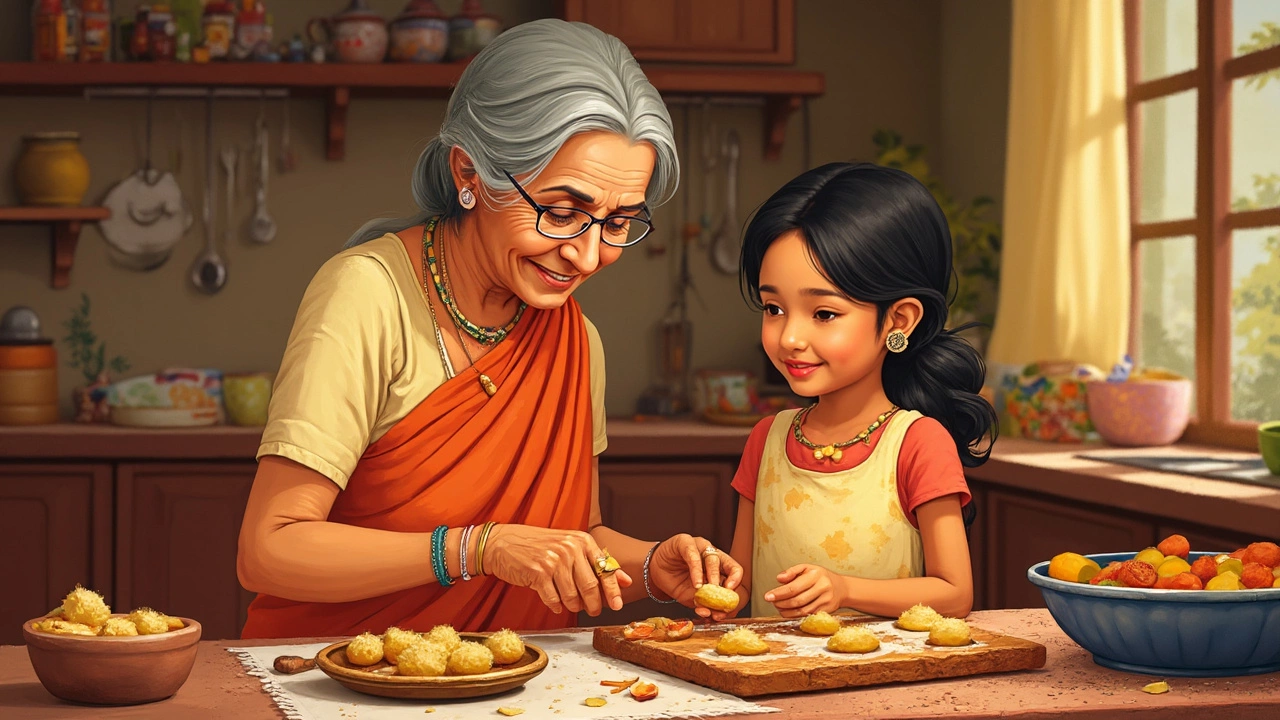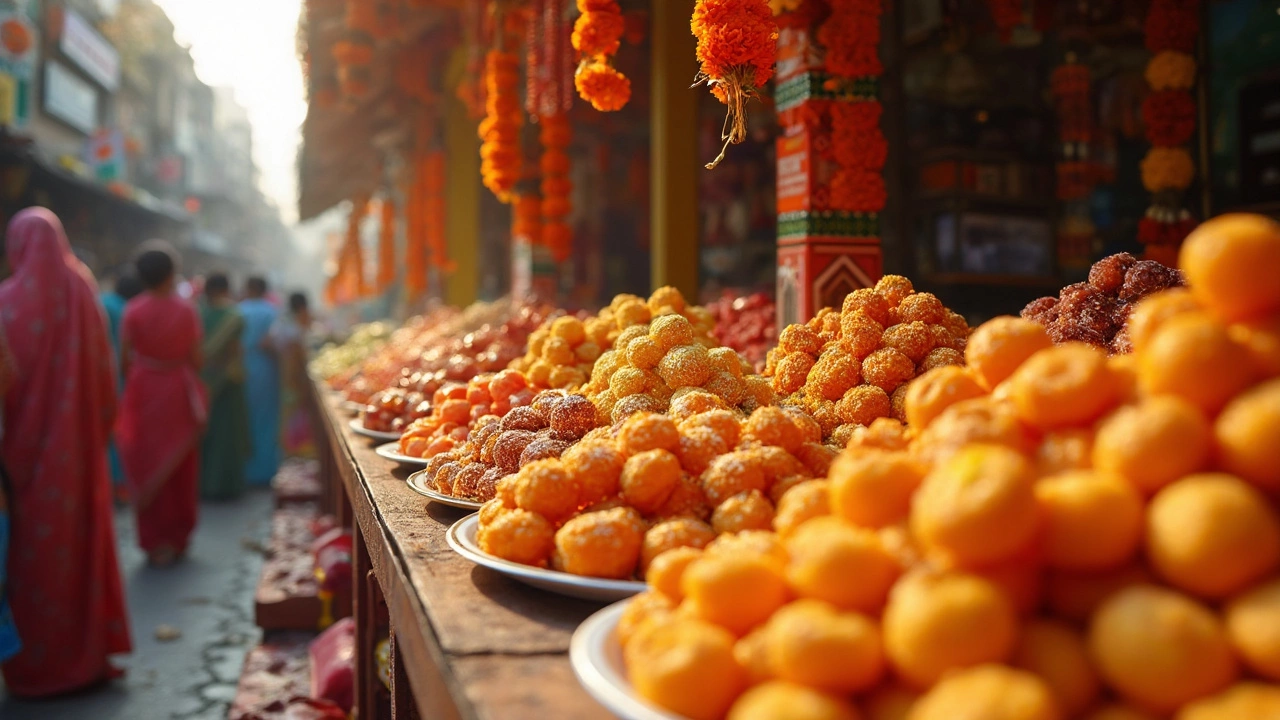When it comes to Indian desserts, it's like being a kid in a candy shop—only better. With a dizzying array of sweets, each region boasts its own special treat. But if you're wondering which one stands head and shoulders above the rest, many foodies would point you towards the soft, pillowy wonder that is Rasgulla.
This delightful dessert hails from eastern India, and it's not just a sugary treat; it's a big piece of Indian culinary culture. Whether served during festive occasions or enjoyed after a regular meal, Rasgulla has a way of making people smile. Plus, it's a cinch to make if you’ve got a few basic ingredients and a little patience.
- History and Diversity of Indian Desserts
- Spotlight on Rasgulla
- The Art of Making Perfect Rasgulla
- Cultural Significance
- Healthy Twists to Traditional Recipes
- Tips for Serving Indian Desserts
History and Diversity of Indian Desserts
India’s dessert scene is like a colorful canvas, reflecting its rich history and cultural diversity. Imagine each region as a unique artist contributing flavors and textures to an already vibrant picture. From north to south and east to west, every state has its own Indian desserts that have been cherished for generations.
The history of Indian sweets goes way back, with mentions in ancient texts like the Vedas. These sweets were not just food; they were offerings for gods and played a part in rituals and celebrations. The tradition of making sweets at home, especially during festivals, is still alive and kicking.
In North India, you've got your rich, nutty delights like jalebi and kalakand, bursting with flavors. In contrast, the South offers lighter, coconut-infused treats like Mysore pak and payasam. Then, head over to the East, and you'll find the Bengali pride called rasgulla, which is a real crowd-pleaser.
The influence of different cultures over the centuries can also be tasted in Indian desserts. Persian and Mughal influences brought with them techniques and ingredients like saffron, nuts, and even the concept of desserts themselves, leading to creations like the syrup-soaked gulab jamun.
| Region | Popular Dessert |
|---|---|
| North India | Gulab Jamun, jalebi |
| South India | Mysore Pak, payasam |
| East India | Rasgulla |
| West India | Modak, basundi |
Despite their regional roots, many of these sweets have gained popularity throughout the country and even internationally. The love for Indian desserts isn't just about the taste; it’s about tradition, celebration, and a bit of that nostalgia that connects people to their past.
Spotlight on Rasgulla
Rasgulla is like the MVP of Indian sweets, especially if you've got a sweet tooth. Originating from the eastern states of Odisha and West Bengal, this dessert has been at the center of a friendly feud, with both claiming it as their own masterpiece. But no matter where it truly started, its delightful taste is undeniable.
Made primarily from chhena (a type of Indian cottage cheese) and semolina, these soft and spongy balls are soaked in a simple sugar syrup. The secret lies in achieving the perfect texture—just the right amount of tenderness and bounce. This isn’t just a dessert; it’s a science!
What really makes Rasgulla stand out in the world of Indian desserts is its simple yet effective ingredient list:
- Chhena: This is the main ingredient, giving Rasgulla its unique texture. Freshly curdled milk is separated into solids and kneaded until smooth.
- Semolina: Just a pinch of semolina is used to bind the chhena so the balls don't fall apart during cooking.
- Sugar Syrup: Rasgulla is cooked in sugar syrup to soak in the sweetness.
Flavored variations often include saffron or cardamom for that extra aroma and taste. And guess what? It's even got a healthier iteration these days, with jaggery replacing regular sugar in some versions!
Talking flavor, we can't overlook the cultural significance. In West Bengal, a modified version called ‘Roshogolla’ is often served during festivals, celebrations, and weddings, making it not just a dessert but a token of goodwill.
The popularity of Rasgulla has even crossed borders and reached far corners of the globe, bringing a piece of traditional Indian sweets recipes to dessert buffs everywhere.
The Art of Making Perfect Rasgulla
So you're ready to embark on the journey of making India's best dessert? Great choice! Rasgulla is all about getting that fluffy texture and rich, sweet flavor just right. Let's break it down.
The backbone of a good Rasgulla is fresh, homemade chenna, which is essentially the Indian version of cottage cheese. To make it, all you need is milk and lemon juice. Here's a simple guide:
- Bring milk to a boil, then gently add lemon juice, stirring until the milk curdles.
- Pour the curdled mix through a muslin cloth, allowing the whey to separate. Rinse with cold water to get rid of the lemony taste.
- Wrap the chenna in the cloth and press it for about 30 minutes to drain excess water.
Your chenna should be moist but crumbly. Knead it with your palm until it's smooth and soft—this is the secret to the perfect Rasgulla texture!
Next, shape the chenna into small balls. They should be crack-free, as cracks can ruin their texture. Now, it's time to cook them up in a sugary syrup:
- Prepare syrup with water and sugar at a 2:1 ratio in a wide pot.
- Add the chenna balls and cover them, letting them simmer for about 15 minutes. Keep the syrup bubbling but not boiling over.
- After 15 minutes, cool them down a bit and serve them with some of the syrup.
If you want to add a little extra flair, you can pop a cardamom pod in the syrup or sprinkle some rose water for a fragrant touch. And voilà, your homemade Rasgullas are ready to be devoured!

Cultural Significance
Rasgulla, a soft and spongy dessert, isn’t just about satisfying a sweet tooth. It's woven deeply into the traditions and celebrations of India. Often enjoyed during festivals like Diwali and Durga Puja, this sweet is as much about bringing people together as it is about its delicious taste.
The origins of Rasgulla are a bit like tales passed down through generations—heartfelt and varied. Though mostly associated with the state of West Bengal, Odisha also lays claim to its invention. In fact, in 2016, Odisha declared that Rasgulla originated there more than 700 years ago as a temple offering. On the flip side, West Bengal secured a Geographical Indication (GI) tag for 'Banglar Rasogolla' in 2017. It's a sweet rivalry that highlights just how significant this dessert is to regional identity.
Beyond geography, Rasgulla is emblematic of the fusion of flavors in Indian cuisine. Made from basic ingredients like chhena (curdled cheese) and sugar syrup, it shows how simplicity can lead to something extraordinary. But it's not just about taste; sharing Rasgullas is a gesture of goodwill. In some regions, brides and grooms feed each other Rasgullas during weddings—a sweet start to a new chapter.
In recent years, Indian desserts like Rasgulla have taken the global stage, finding spots on dessert menus across the world. They add a touch of Indian warmth and hospitality to international palettes, making every event a bit sweeter.
Healthy Twists to Traditional Recipes
If you've got a sweet tooth but want to stay on the healthy side of things, you don't have to give up on India's best dessert, the Rasgulla. Believe it or not, this classic can be reinvented to fit a more health-conscious lifestyle without losing its charm.
First up, consider swapping out the sugar. You can use natural sweeteners like honey or jaggery. Not only do they bring down the calorie count, but they also add a depth of flavor that's both earthy and rich. It's like hitting two birds with one stone!
According to Dr. Anita Sharma, a noted nutritionist, "Switching to natural sweeteners can reduce the glycemic index of your favorite Indian desserts significantly, making them a healthier option for dessert lovers."
Another simple tweak is to replace full cream milk with low-fat or plant-based options like almond or oat milk. This little change cuts down on fat without compromising on taste. Just make sure the milk is unsweetened to keep it truly guilt-free.
| Nutritional Comparison | Traditional Rasgulla | Healthy Rasgulla |
|---|---|---|
| Calories (per piece) | 150 | 100 |
| Sugar (g) | 30 | 15 |
| Fat (g) | 7 | 3 |
If you're looking to sneak in some extra nutrients, toss in a pinch of nuts or seeds. They add a nice crunch and take the nutrition up a notch with healthy fats and proteins.
- Step 1: Dissolve jaggery in warm plant-based milk to maintain the authentic taste.
- Step 2: Prepare the chenna (cottage cheese) and form it into smooth dough balls.
- Step 3: Cook in the jaggery syrup until soft and spongy.
- Step 4: Add crushed almonds or sunflower seeds before serving for an added health boost.
Healthy Indian sweets recipes like this prove that you can have your cake and eat it too—without worrying about your waistline. Feel free to experiment with these tips and find your perfect healthy blend!
Tips for Serving Indian Desserts
Serving Indian desserts can be an art in itself. It's not just about enticing flavors but also about presentation and timing. Here’s how to ace the dessert game, leaving your guests craving more!
First off, think about your timing. Most Indian sweets like Rasgulla or Gulab Jamun are served slightly warm. So, make sure to heat them just a bit before serving, but not too hot. It brings out the flavors beautifully.
Another tip? Consider pairing your desserts with a hot beverage like tea or coffee. This isn't just about tradition; it's about balancing flavors, as the richness of the sweets complements the drink.
"Indian desserts are best enjoyed when served fresh and in good company," says acclaimed chef Sanjeev Kapoor.
Presentation is key. Invest in some traditional Indian serveware if you want to go the extra mile. Brass or copper bowls can make a humble dessert look like a royal feast.
- Garnishing: A sprinkle of crushed nuts or a few strands of saffron can add a pop of color and a touch of luxury to your dessert.
- Portioning: Indian desserts are typically rich, so small portions are ideal. This way, guests can enjoy without feeling overwhelmed.
- Mix and Match: Offer a variety of desserts in small portions. This allows your guests to sample different flavors without overindulging in any one item.
Finally, remember to keep allergies and dietary preferences in mind. Offering a mix of traditional and healthier versions can earn you serious hosting points.
With these tips, serving India's best dessert becomes a breeze. Just remember, the goal is to make your guests feel welcomed and satisfied.
